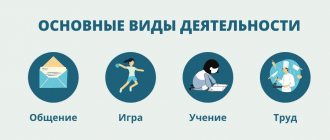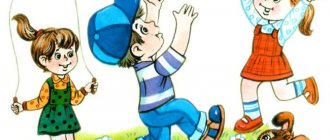Games are a great way to organize a group of people for joint activities, encourage a person to take certain actions, increase motivation and look at routine work from a new perspective. The famous example of Tom Sawyer, described by Mark Twain, shows that you can captivate others even with such a boring task as painting a fence - if you approach the matter with imagination.
Game technologies in pedagogy “work” in a similar way. They help present the educational process as an entertaining, interesting activity, preserving all its benefits. This is an integral part of preschool, school and even vocational education.
Game-based learning technologies are ways, methods and techniques by which a teacher (teacher):
- sets situations in which students must find themselves in order to gain knowledge or practical useful experience;
- creates circumstances that encourage students to make independent decisions - in order to later draw conclusions and work through mistakes;
- offers a choice - different social roles and “masks”, options for solving problems that allow you to get to know yourself better, control your behavior, and cope more effectively with a difficult matter;
- creates an environment for increasing motivation by activating the imagination, the “spirit of competition,” excitement, and group activities.
Functionality of the teaching method
Play is the most important aspect of children's interactive learning. It allows the child’s personality to develop more freely, revealing individuality and realizing natural abilities and inclinations. While playing, children of preschool and school age remember more information, absorb it better, and learn to work with their rational thinking and emotions. Therefore, gaming technologies in pedagogy have many functions that can even be called missions. This:
- Motivation and self-realization. The child should not be forced to play. He will willingly complete the task himself and treat it responsibly. With the help of gaming technologies, you can awaken children's interest in a useful process, entertain them and inspire them to new achievements.
- Socialization. Game-based pedagogical technologies place children in conditions where they must interact with other participants. A safe and interesting environment helps to overcome pressures and embarrassment, learn to understand others, make it easier to make contact and not be afraid of it.
- Communication, including interethnic and intercultural. When playing, it is easier for children to understand people with views and principles. different from their own. This helps to assimilate the general sociocultural values of civilization.
- Therapy and correction. Using gaming technologies, you can resolve a difficult situation by projecting it onto an emotionally comfortable and understandable situation. Psychological and behavioral correction occurs naturally, helping students overcome antisocial behavior and emotional trauma.
- Diagnostics. Game techniques make it easier for the teacher to determine the child’s inclinations and personality characteristics. This helps to select effective educational methods. Children reveal themselves to the maximum during play and do not hide their true emotions, which increases the accuracy of psychological and pedagogical diagnostics.
The use of gaming pedagogical technologies in the educational process of preschool educational institutions
“Children should live in a world of beauty, games,
fairy tales, music, drawing, fantasy, creativity.”
Vasily Sukhomlinsky.
An important and first link in the education system is a preschool educational institution. Developing the skills of self-assessment and selection of received information is the main task of teaching preschoolers. Gaming technologies help to develop such a skill, serving as a kind of practice for using the knowledge acquired by children in education. A child plays, which means he is happy, which means he is healthy. With the help of gaming technologies, a child gets to know himself and his capabilities. The main activity for the comprehensive development of a preschooler is play.
The child must be given the opportunity to live his childhood in the game, while forming knowledge based on motivation, this is the main goal of using gaming technology.
The relevance of this topic and the successful solution of educational problems require close attention to the problems of children's play. In order to educate and teach children various actions with objects, methods and means of communication, play is used as the main type of children's activity. In it, the preschooler develops his personality, forming those aspects of the psyche that influence successful educational and work activities, his relationships with people. In our work with children, we pay special attention to games, motivating children’s play actions, directly participating and becoming emotionally involved in their activities. Gaming technologies arouse increased interest and positive emotions in children, which is the main advantage in learning. It is possible to concentrate attention on the educational task, which becomes not imposed from the outside, but a desired, personal goal, with the help of a game.
As a result of experience, preschoolers more easily learn material of any complexity if the game situation is close to real life conditions. To understand their play plans and experiences, the teacher must observe the children, and it is necessary to gain the children’s trust and establish contact with them. This is easily achieved if the teacher takes the game seriously, with sincere interest, without offensive condescension.
In our work, we use modern gaming technologies, which are the main feature, penetrating into all types of children’s activities: work and play, educational activities and play, everyday household activities related to the implementation of the regime and play. The most effective can be considered verbal didactic games - one of the oldest types of didactic games. Their uniqueness lies in the fact that they contribute to the comprehensive development of the child’s personality, since the topics of word games can be very diverse; These games contribute to the development of the child’s creative thinking, word creation, enrich the players’ vocabulary, and help master the grammar of their native language. An important feature of most verbal games is that they do not require preliminary preparation or special equipment, therefore, they can be used in any type of children's activity: during classes, on walks, in independent activities of children in groups. We actively use verbal didactic games during classes on speech and cognitive development, which allows children to master any difficult material (“Choose the words”, “Who lives in the house”, “Choose the action”) while laughing and playing.
Gaming technologies aimed at developing attention make a gradual transition in preschoolers from involuntary to voluntary attention. Voluntary attention involves the ability to concentrate on a task, even if it is not very interesting. In our work we use game exercises “Correct the mistakes”, “Find the mistake”, “Find the differences”, “Fold the picture”, etc.
Gaming technologies also contribute to the development of a child’s thinking. We use didactic games that allow you to teach your child the ability to reason, find cause-and-effect relationships, and make inferences: “Arrange the objects,” “Be attentive,” “Say the opposite,” “Match a word,” “What is this?” Who is this?".
Gaming technologies help in the development of memory, which, like attention, gradually becomes voluntary. We use specially designed games, such as “Shop”, “Remember the pattern”, “Draw as it was”, etc.
The main direction in modern gaming technologies is information computer technologies. They empower parents, educators and early learning ICT professionals. During the play activity of a preschooler, enriched with computer tools, mental new formations arise: theoretical thinking, developed imagination, the ability to predict the result of an action, design qualities of thinking, etc., which lead to a sharp increase in the creative abilities of children. Practice has shown that interest in classes increases significantly and the level of cognitive capabilities increases. The teacher's use of ICT increases the child's creativity.
The use of gaming pedagogical technologies in all spheres of a preschooler’s life will significantly increase the level of his psychological preparedness for learning at school and will contribute to the subsequent formation of educational activities.
Summing up, we can conclude that the systematic work I carry out develops my children comprehensively, increases the level of imagination and creative approach to solving problem situations and is embodied in creative activity through unusual ideas, deviating from traditional patterns. The game creates the next stage for a new leading activity - educational. Optimization and organization of a special space in a preschool educational institution for activating, expanding and enriching the play activities of a preschooler is the most important task of teaching practice.
Using gaming technology in action
A game is useful if it is as close as possible to real life situations. Therefore, it needs to be integrated into the educational process. Gaming technologies are used independently and as an element of a more general, traditional teaching methodology. They help children more easily master the topics of academic disciplines, and it is easier for a teacher or extracurricular teacher to control and guide the process.
However, you need to be able to use the game method in order for it to have an effect. When using such technologies in action, it is necessary:
- draw up plans, goals in advance and carefully develop the components of the game - images, conditions, processes, plot, communication between participants;
- set a didactic goal for the participants, but reproduce the rules only in a playful form;
- use educational material as a means of play;
- connect the result of the game with the completion of a learning task - for example, you can win by solving an exercise well or memorizing a poem;
- build a lesson according to the rules of the game - the work and behavior of students should depend on them;
- introduce a competitive element into the educational process - it helps to transform a didactic task into a game one.
When using gaming technologies, it is important to decide whether they are relevant for a specific topic or subject of study and to monitor the balance of the entertainment component and the actual study.
Game technologies in working with preschool children
Victoria Iskra
Game technologies in working with preschool children
Report “ Game technologies in working with preschool children ”
“Game is the way for children to understand the world,
in which they live and which they are called to change.”A. M. Gorky.
Gaming technologies are widely used in preschool age , since play at this age is the leading activity during this period. In activities with the help of gaming technologies, children develop mental processes.
The main goal of gaming technology is to create a full-fledged motivational basis for the formation of skills and abilities of activity, depending on the operating conditions of the preschool institution and the level of development of children.
Her tasks:
Achieve a high level of motivation, a conscious need to acquire knowledge and skills through the child’s own activity.
Select means that activate children’s activities and increase their effectiveness.
Game-based pedagogical technology is the organization of the pedagogical process in the form of various pedagogical games. This is the consistent activity of the teacher in: selection, development , preparation of games; inclusion of children in play activities ; implementation of the game itself; summing up the results of gaming activities .
Gaming technologies are closely related to all aspects of the educational work of a kindergarten and the solution of its main tasks.
Gaming technology should be aimed at solving the following problems:
a didactic goal is set for children in the form of a game task ;
activity is subject to the rules of the game;
educational material is used as its means;
an element of competition is introduced into the activity, which transforms the didactic task into a game one ;
successful completion of a didactic task is associated with the game result .
The game form of organized educational activity is created by game motivation , which acts as a means of motivating and stimulating children to learn.
A game is the freest form of human immersion in real or (imaginary)
reality for the purpose of studying it, manifestation of one’s own
“I”
, creativity, activity, independence, self-realization.
The game has the following functions: relieves tension and promotes emotional release; helps the child change his attitude towards himself and others, change his methods of communication, and his mental well-being.
Gaming technology includes:
• games and exercises that develop the ability to identify the characteristic features of objects;
• groups of games to generalize objects according to certain characteristics;
• groups of games, during which preschoolers develop the ability to distinguish real from unreal phenomena;
• groups of games that develop the ability to control oneself , speed of reaction to a word, ingenuity, etc.;
The game activates the psychological processes of participants in gaming activities : attention, memorization, interest, perception and thinking.
In the game, it is possible to involve everyone in active work ; this form of activity is opposed to passive listening and reading. During the game, an intellectually passive child will freely complete a volume of work that is completely inaccessible to him in a normal situation.
For preschool , the leading activity is play.
Psychologists consider play in preschool age as an activity that determines the child’s mental development, as a leading activity, during which mental new formations arise.
The types of pedagogical games are very diverse.
They may vary:
by type of activity - motor, intellectual, psychological, etc.;
by the nature of the pedagogical process - teaching, training, controlling, cognitive, educational, developmental, diagnostic.
by the nature of the gaming methodology - games with rules; games with rules established during the game; a game where one part of the rules is specified by the conditions of the game, and is established depending on its progress.
by content - musical, mathematical, logical, etc.
by gaming equipment - tabletop, computer, theatrical, role-playing, etc.
The main component of gaming technology is direct, systematic communication between the teacher and children.
The educational and educational value of the game depends on:
— knowledge of the methodology of gaming activities ;
- professional skills of the teacher in organizing and managing various types of games;
— taking into account age and individual capabilities.
Using gaming technologies in the educational process, I use a lot of goodwill, try to provide emotional support, create a joyful environment, and encourage any invention and fantasy of the child. Only in this case will the game be useful for the development of the child and the creation of a positive atmosphere of cooperation with adults.
At first I used gaming technologies as gaming moments . Game moments are very important in the pedagogical process, especially during the period of adaptation of children in a child care institution. When working with children four to five years old, my main task is to develop emotional contact, children’s trust in the teacher, the ability to see in the teacher a kind person, always ready to help, an interesting partner in the game. I use frontal play situations so that no child feels deprived of attention. These are games like "Round Dances"
,
"Catch-up"
.
In my activities, I daily use play moments in classes , in the free activities of children, on walks, during various games: these are finger gymnastics in poetic and playful form , and articulatory gymnastics, role-playing games, didactic games, outdoor games, games low mobility, speech games and tasks develop the child’s speech well and prepare for successful learning at school
Playful moments should be present in all types of children’s activities: work and play, educational activities and play, everyday household activities related to the implementation of the regime and play.
Already in early childhood, a child has the greatest opportunity in play, and not in any other activity, to be independent, to communicate with peers at his own discretion, to choose toys and use different objects, to overcome certain difficulties logically related to the plot of the game, its rules.
For example: I’m using the game situation “” - Who will roll their figurine to the toy gate faster?” involving children in a fun game-competition: “Such figures can be a ball and a cube, a square and a circle.
Children conclude that sharp corners prevent the cube and square from rolling: “The ball rolls, but the cube does not.” Then we fix this by drawing a square and a circle.
Such gaming technologies are aimed at developing perception.
Technology of educational games B. P. Nikitina:
game program consists of a set of educational games, which, with all their diversity, are based on a general idea and have characteristic features.
Each game is a set of problems that the child solves with the help of cubes, bricks, squares made of cardboard or plastic, parts from a mechanical designer, etc. In his books, Nikitin offers educational games with cubes, patterns, Montessori frames and inserts, plans and cards, squares, “Guessing”
,
“dots”
,
“clock”
, thermometer, bricks, cubes, constructors.
Children play with balls, ropes, rubber bands, pebbles, nuts, corks, buttons, sticks, etc., etc. Subject-based educational games are the basis of construction, labor and technical games , and they are directly related to intelligence.
Gaming technologies help in the development of memory, which, like attention, gradually becomes voluntary. “Shop” will help children with this.
, “Mothers and Daughters”,
“Remember the picture”
.
Gaming technologies contribute to the development of a child's thinking. As we know, the development of a child’s thinking occurs when he masters three main forms of thinking: visual-effective, visual-figurative and logical. Visual-effective is thinking in action. It develops in the process of using gaming techniques and teaching methods during the implementation of actions, games with objects and toys. Figurative thinking - when a child has learned to compare, highlight the most essential in objects and can carry out his actions, focusing not on the situation, but on figurative ideas. Many didactic games are aimed at developing imaginative and logical thinking. Logical thinking is formed in the process of teaching a child the ability to reason, find cause-and-effect relationships, and make inferences.
Naturally, the integrated use of gaming technologies for different purposes helps prepare a child for school. The problems of forming intellectual readiness for school are solved by games aimed at developing mental processes, as well as special games that develop in a preschooler , introduce him to the sound analysis of words, and prepare his hand for mastering writing.
Thus, gaming technologies are closely related to all aspects of the educational work of a kindergarten and the solution of its main tasks.
The goal of play therapy is not to change or remake the child, not to teach him any special behavioral skills, but to give him the opportunity to “live”
in the game, situations that excite him with the full attention and empathy of an adult.
If children are systematically engaged in play therapy, they acquire the ability to manage their behavior. Their play activities begin to be dominated by role-playing games depicting people’s relationships. Folk games with dolls, nursery rhymes, round dances, and joke games are used as one of the effective types of game therapy
Using folk games “Cat and Mouse”
,
“Hide and Seek”
,
“Blind Man's Bluff”
, in my
work I not only implement the educational and developmental functions of gaming technologies , but also various educational functions: at the same time I introduce students to folk culture.
This is an important component of the kindergarten educational program. The use of gaming technology for theatrical activities helps me enrich children in general with new impressions, knowledge, skills, develops interest in literature and theater, forms dialogical, emotionally rich speech, activates the vocabulary, and promotes the moral and aesthetic education of each child.
Summarizing what has been said, I want to conclude that the use of gaming technologies in my pedagogical work helps to influence the quality of the educational process, to increase the efficiency of raising and teaching children and to remove the negative consequences of education.
Play activities take place very lively, in an emotionally favorable psychological environment, in an atmosphere of goodwill, freedom, equality, in the absence of isolation of passive children. Gaming technologies help children to relax and gain self-confidence. As experience shows, acting in a game situation close to real life conditions, preschoolers more easily learn material of any complexity.
Thus, understanding that play is an important activity in preschool age , I try to organize it so that every child, living through preschool childhood , can gain knowledge, skills and abilities that he will carry throughout his life. And depending on how I teach him to convey relationships between people, he will build real relationships.
List of used literature:
1. Kasatkina E.I. Game in the life of a preschooler . - M., 2010.
2. Kasatkina E.I. Game technologies in the educational process of preschool educational institutions. //Management of preschool educational institution. - 2012. - No. 5.
3. Penkova L. A., Konnova Z. P. Development of play activity in preschoolers .
4. Anikeeva N.P. Education through play/N . P. Anikeeva. - Moscow, 1997. p. 5-6
5. Elistratova I. Let's play with you. //My child/I. Elistratova. - No. 11.-2006.-p. 22-30.
6. Zaporozhets A.V., Markova T.A. Game and its role in the development of a preschool . - Moscow, 1998, 8-12. Educator:
Iskra Victoria Vasilievna, b. Ust-Abakan village, 2018
Types of pedagogical games
Each gaming technology consists of individual techniques - that is, games. There are many types of them, which allows you to flexibly choose teaching tools and combine them with didactic techniques for a deeper immersion in the topic. Games are classified according to several criteria:
- according to the “resources” of the students involved in it - games can be physical, mental, emotional and psychological, or combined;
- by type of pedagogical process - educational, communicative, cognitive, reproductive;
- by type and method of organizing the process - questioning and testing, competition and competition, theatrical performance and dramatization game, holiday, training;
- according to the level of severity of the rules - with pre-established frameworks, with conditions determined during the game and improvisational;
- on the construction of the process - plot, role, subject, simulation, business.
Games can use sports equipment, objects, computer equipment or virtual space. Most often, strict rules are set for physical and intellectual forms. The free flow of the process is inherent in creative types - musical, theatrical, festive. The teacher determines the specifics and additional conditions of the game, focusing on the characteristics of the students (pupils) and the material being studied.
To properly use games in the educational process, special education is required. His main areas are preschool and school pedagogy, social and pedagogical activities, and teaching in primary grades. You can get such an education at ANPOO "NSPK". You can learn more about distance* programs from the college admissions office.
* Form of study – correspondence. Educational programs are implemented using e-learning and distance learning technologies.
Gaming technologies for preschoolers
The age of children in which the foundations of personality are laid, will is developed, and social competence is formed is called preschool. It is unique and decisive at the beginning of a child’s developmental stage. Game-based learning should be interesting, entertaining, but not entertaining.
Game pedagogical technology is the organization of the pedagogical process in the form of various pedagogical games . This concept differs from games in that they have a clearly defined goal and a corresponding pedagogical result. Game-based pedagogical technology includes various methods and techniques for organizing the pedagogical process in the form of games. The result of the games is justified, observed explicitly and characterized by a certain educational focus.
The goal of gaming technology is to create a full-fledged motivational basis for the formation of skills and abilities of activity, depending on the operating conditions of the preschool institution and the level of development of children.
Games are mainly children’s own initiative, therefore, when organizing gaming activities, the teacher must be guided by the following requirements:
- game selection. Should act as a means of satisfying the interests and needs of children. Typically, the choice of game depends on educational tasks that require their logical solution. That is, children show interest in the game, actively act and get a result veiled by the game task - there is a natural substitution of motives from educational to gaming;
- game proposal. A gaming problem is created. To solve it, children are offered various game tasks, such as action techniques and rules;
- explanation of the game. The teacher briefly and clearly explains the rules and techniques of the game, but only after the children’s interest in the game arises;
- gaming equipment. It must comply as much as possible with the content of the game and all the requirements for the subject-game environment according to the Federal State Educational Standard;
— organization of a gaming group. Game tasks are formulated in such a way that each child can demonstrate their activity and organizational skills. Children can act depending on the progress of the game individually, in pairs or teams, collectively;
- development of the game situation. It is characterized by the following principles: the absence of coercion of any form when involving children in the game; the presence of game dynamics; maintaining a gaming atmosphere; the relationship between gaming and non-gaming activities;
- end of the game. The result of children's gaming activities should be analyzed and aimed at application in real life.
Based on the nature of the pedagogical process, the following groups of games are distinguished:
— teaching, training, controlling, generalizing;
- cognitive, educational, developmental;
- reproductive, productive, creative, communicative, diagnostic, career guidance, psychotechnical and others.
Types of pedagogical games can be very diverse . They are divided:
- By type of activity - motor, intellectual, psychological, etc.
- By the nature of the pedagogical process - teaching, training, controlling, cognitive, educational, developmental, diagnostic.
- The nature of the gaming methodology is games with rules; games with rules established during the game; a game where one part of the rules is specified by the conditions of the game, and is established depending on its progress.
- In terms of content - musical, mathematical, socializing, logical, etc.
- By gaming equipment - tabletop, computer, theatrical, role-playing, director's, etc.
The gaming technology component is the direct interaction and communication between the teacher and children, which is immediate and systematic. Game Technology Component:
— activates students;
- increases cognitive interest;
- causes emotional uplift;
- promotes the creative development of the child;
— concentrates class time as much as possible due to clearly formulated game conditions;
— allows the teacher to change the strategy and tactics of game actions by complicating or simplifying game tasks, depending on the level of mastery of the material.
Gaming technology is organized as a holistic education, which covers some part of the educational process, and also unites it with common content, plot, and character. It includes sequentially:
- games and exercises that develop the ability to identify the main, characteristic features of objects, compare and contrast them;
- groups of games to generalize objects according to certain characteristics;
- groups of games, during which preschoolers develop the ability to distinguish real from unreal phenomena;
- groups of games that develop the ability to control oneself, speed of reaction to a word, phonemic awareness, ingenuity, etc.
The task of each teacher is to compile gaming technologies from individual games and elements. In the last decade, in connection with the development of the world community, the human personality has become a priority at the center of the education and upbringing system. The main component of the formation of the human personality is the teacher, who is at the same time the bearer of universal human values and the creator of a creative personality. Constant fluctuations and changes in society determine the difficulty for the teacher and confront him with the need for value self-determination, requiring him to implement democratic and humanistic principles in pedagogical activity. In other words, the basis of a teacher’s activity is the definition and use of his personal creative potential, which is the system-forming factor of the author’s pedagogical system, the ascent from individual pedagogical functions (actions, situations) to their system, from standard technologies to creative, personality-oriented ones, which are based on there should be a dialogical approach, pedagogical training, role-playing games, analysis of the pedagogical situation, creation of a “situation of success”, co-creation in conducting and preparing creative comprehensive educational activities.
If a teacher uses the latest pedagogical technologies, what qualities should he have? Today, the priority and sought-after qualities of a teacher are such personal qualities (image) as the art of communication, openness, sincerity, goodwill, erudition, outlook, artistry, charm, empathy, improvisation, imagination, reflection, the ability to detect “new formations” and changes in time. in the relationships of children, their moods, reactions. Thus, gaming technologies help children to relax and show self-confidence, while facilitating easy learning of material of any complexity, by bringing the gaming situation closer to real life conditions.
Literature:
- Kasatkina E.I. Game in the life of a preschooler. - M., 2010.
- Kasatkina E.I. Game technologies in the educational process of preschool educational institutions. //Management of preschool educational institution. - 2012. - No. 5.





